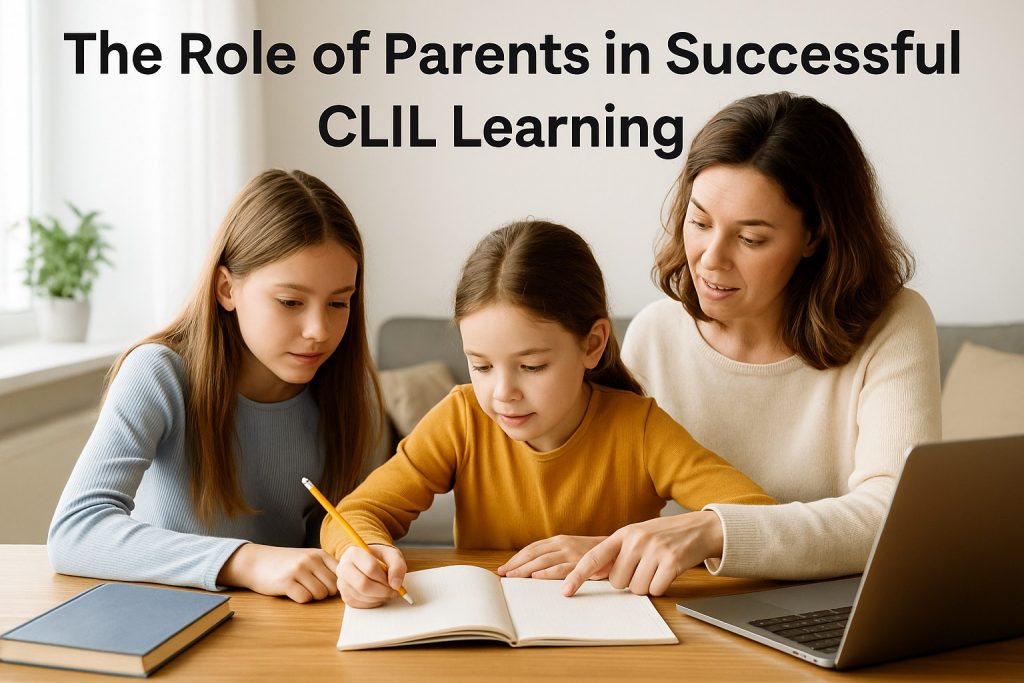
When we talk about CLIL (Content and Language Integrated Learning), we often focus on the curriculum, teacher training, or classroom activities. But there’s another key ingredient that often gets overlooked: parents. A child’s attitude toward learning, especially through a second language, is shaped not just by teachers but by what happens at home too.
CLIL is not the usual way most of us learned a foreign language. Many parents naturally feel unsure at first when they hear their child is learning science or math in English (or any other target language). It’s normal to worry: Will my child fall behind in content? Will they get confused switching between languages? These are valid questions. That’s why clear, honest communication between schools and families is so important.
When parents know how CLIL works, they’re much more likely to get involved and become real partners in the learning process. Small things make a big difference — helping with homework, encouraging kids to use the new language at home, or simply showing an interest. Maybe it’s watching an English-language nature documentary together, reading a bilingual storybook, or discussing a topic your child is curious about. These shared moments boost confidence and make learning feel relevant beyond the classroom.
Teachers also have a big role here. It’s crucial for schools to explain what a CLIL lesson looks like, what kind of language support students get, and what realistic progress is. Parent meetings, newsletters, school events, and even short workshops can help parents feel informed and reassured. When families feel included, they trust the process — and children sense that.
In multicultural classrooms, parental involvement becomes even more meaningful. CLIL, by its nature, respects different languages and cultures, giving all students equal access to learning. Schools can make an extra effort to reach out to parents who speak other languages — for example, by offering translated materials or interpreters at meetings. This helps families feel welcome and connected, no matter their background.
One of the best things about CLIL is that it ties language to real life. You don’t have to be fluent in English (or the target language) to support your child. Your encouragement, curiosity, and willingness to get involved are what count. Schools can help too, by providing simple tools like bilingual glossaries, short videos, or practical tips so parents don’t feel left out.
Some schools take this further with creative ideas like “CLIL open days” where parents join lessons, family workshops where everyone learns together, or take-home CLIL activity kits with games, books, and small projects. These not only help children learn but also give parents a clearer picture of how CLIL works.
At the end of the day, parental involvement isn’t just a nice bonus — it’s a real pillar of success for any CLIL program. When parents, teachers, and students work together, kids feel more supported, more motivated, and more confident using both languages. The message is clear: learning is valuable, possible, and worth celebrating — at school and at home.
Dr.Humeyra Turedi
References
- Mehisto, P., Marsh, D., & Frigols, M. J. (2008). Uncovering CLIL. Macmillan Education.
- Hornby, G. (2011). Parental Involvement in Childhood Education: Building Effective School-Family Partnerships. Springer.
- Lasagabaster, D., & Sierra, J. M. (2009). Language attitudes in CLIL and traditional EFL settings. International CLIL Research Journal, 1(2), 4–17.
- Henderson, A. T., & Mapp, K. L. (2002). A New Wave of Evidence: The Impact of School, Family, and Community Connections on Student Achievement. Southwest Educational Development Laboratory.
- Piller, I. (2016). Linguistic Diversity and Social Justice: An Introduction to Applied Sociolinguistics. Oxford University Press.
CLIL Programlarında Ebeveyn Katılımı: Neden Önemlidir?
Dr. Hümeyra Türedi
CLIL (İçerik ve Dil Bütünleştirmeli Öğrenim) üzerine konuşurken genellikle müfredata, öğretmen eğitimine veya sınıf içi etkinliklere odaklanırız. Ancak sıkça gözden kaçan bir başka önemli unsur daha var: Ebeveynler. Bir çocuğun öğrenmeye, özellikle de ikinci bir dil aracılığıyla öğrenmeye karşı tutumu yalnızca öğretmenler tarafından değil, evde yaşananlarla da şekillenir.
CLIL, çoğumuzun bir yabancı dili öğrendiği klasik yöntemlerden farklıdır. Bu nedenle birçok ebeveyn, çocuklarının fen ya da matematik gibi dersleri İngilizce (ya da başka bir hedef dil) aracılığıyla öğreneceklerini duyduklarında doğal olarak kaygı duyabilir. “Çocuğum içerik açısından geri mi kalır?”, “İki dili bir arada kullanmak kafasını karıştırır mı?” gibi sorular oldukça geçerlidir. İşte bu yüzden okulla aileler arasında şeffaf ve dürüst bir iletişim çok önemlidir.
Ebeveynler CLIL’in nasıl işlediğini anladıklarında sürece daha aktif katılır ve öğrenme yolculuğunun gerçek bir parçası hâline gelirler. Küçük katkılar bile büyük fark yaratır — ödevlere yardımcı olmak, çocuklarını evde hedef dili kullanmaya teşvik etmek ya da sadece merak gösterip sürece ilgi duymak. Belki birlikte bir doğa belgeseli izlemek, iki dilli bir hikâye kitabı okumak ya da çocuğun merak ettiği bir konuyu birlikte konuşmak gibi basit anlar bile çocukların özgüvenini artırır ve öğrenmeyi sınıf dışına taşır.
Bu noktada öğretmenlere de büyük görev düşer. Okulların, bir CLIL dersinin nasıl işlendiğini, öğrencilere ne tür dil desteği sağlandığını ve nasıl bir ilerlemenin beklendiğini ailelere açıkça anlatması gerekir. Veli toplantıları, bültenler, okul etkinlikleri hatta kısa atölye çalışmaları ebeveynlerin kendilerini bilgilendirilmiş ve güvende hissetmelerini sağlar. Aileler sürece dâhil olduklarında, hem sürece güven duyarlar hem de bu güveni çocuklarına yansıtırlar.
Çok kültürlü sınıflarda ise ebeveyn katılımı daha da anlamlı hâle gelir. CLIL, doğası gereği farklı dil ve kültürlere saygı duyar, tüm öğrencilere eşit öğrenme fırsatları sunar. Okullar, farklı anadillere sahip ebeveynlere ulaşmak için özel çaba gösterebilir — örneğin, çeviri yapılmış bilgilendirme materyalleri sunmak ya da toplantılarda tercüman desteği sağlamak gibi. Bu tür adımlar, tüm ailelerin kendilerini okul topluluğuna ait hissetmelerini sağlar.
CLIL’in en güzel yanlarından biri, dili gerçek hayatla ilişkilendirmesidir. Ebeveynlerin çocuklarını desteklemek için hedef dili akıcı konuşmaları gerekmez. Meraklı olmaları, teşvik edici bir tutum sergilemeleri ve sürece katılmaya istekli olmaları yeterlidir. Okullar da bu noktada basit araçlar sunarak aileleri sürecin dışında kalmaktan kurtarabilir — iki dilli sözlükler, kısa videolar ya da pratik ipuçları gibi.
Bazı okullar bu süreci daha da ileriye taşıyarak “CLIL açık günleri” düzenler — veliler sınıfa girip derse katılır, aile atölyelerinde birlikte öğrenir ya da içinde oyunlar, kitaplar ve küçük projeler olan “evde CLIL” setleri sunarlar. Tüm bunlar hem çocukların öğrenmesini destekler hem de ebeveynlerin CLIL yaklaşımını daha iyi anlamalarını sağlar.
Sonuç olarak, ebeveyn katılımı yalnızca hoş bir katkı değil; başarılı bir CLIL programının temel direklerinden biridir. Ebeveynler, öğretmenler ve öğrenciler birlikte çalıştığında, çocuklar kendilerini daha desteklenmiş, daha motive olmuş ve her iki dili kullanma konusunda daha özgüvenli hisseder. Verilen mesaj nettir: Öğrenmek değerlidir, mümkündür ve hem okulda hem evde kutlanması gereken bir süreçtir.
Kaynakça
Mehisto, P., Marsh, D., & Frigols, M. J. (2008). Uncovering CLIL. Macmillan Education.
Hornby, G. (2011). Parental Involvement in Childhood Education: Building Effective School-Family Partnerships. Springer.
Lasagabaster, D., & Sierra, J. M. (2009). Language attitudes in CLIL and traditional EFL settings. International CLIL Research Journal, 1(2), 4–17.
Henderson, A. T., & Mapp, K. L. (2002). A New Wave of Evidence: The Impact of School, Family, and Community Connections on Student Achievement. Southwest Educational Development Laboratory.
Piller, I. (2016). Linguistic Diversity and Social Justice: An Introduction to Applied Sociolinguistics. Oxford University Press.



